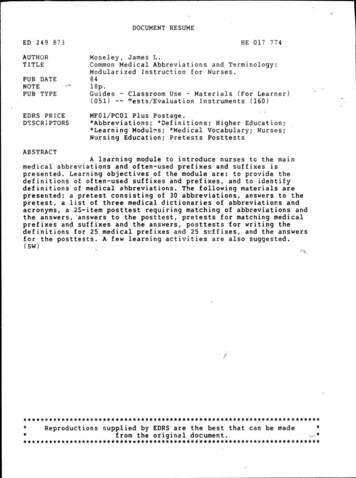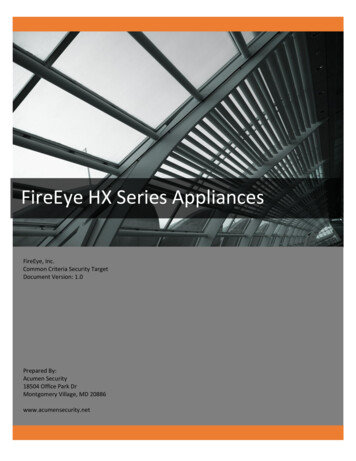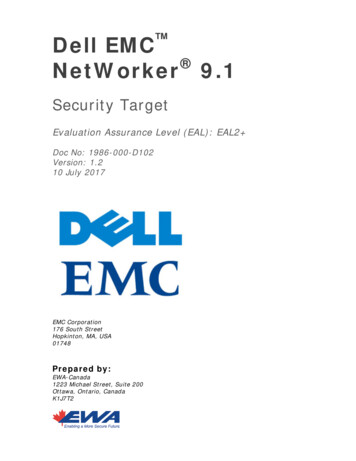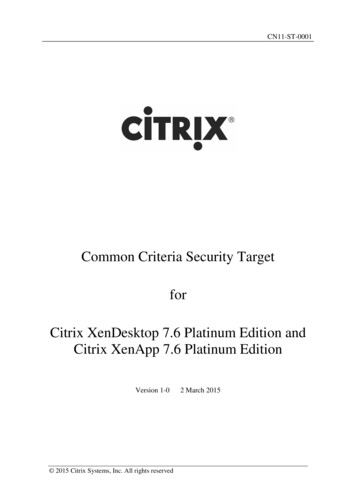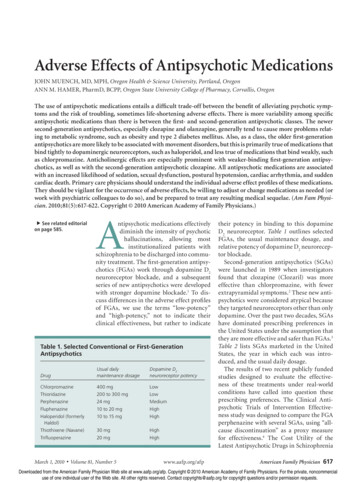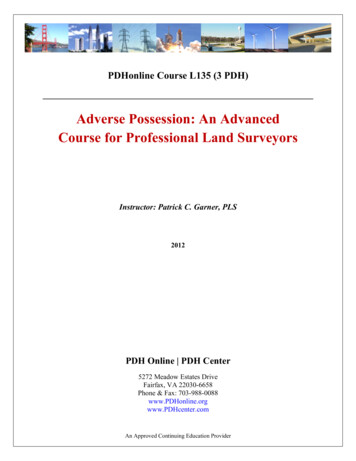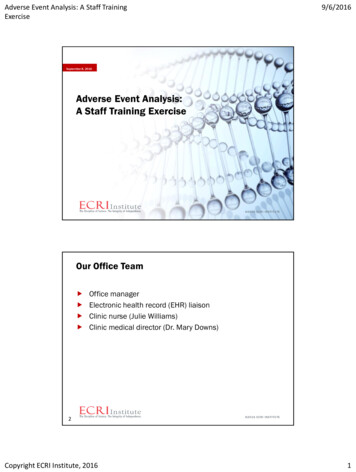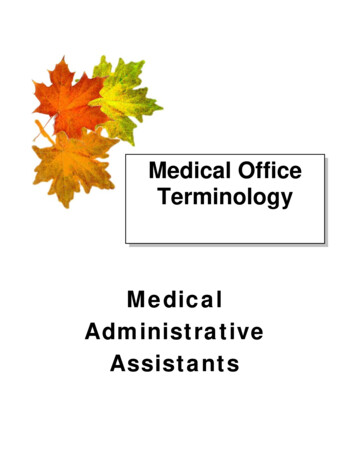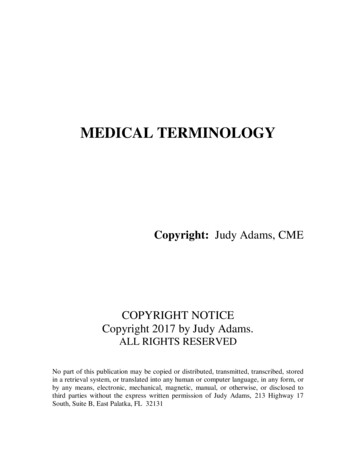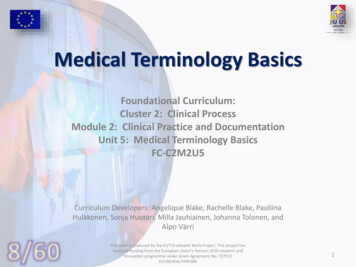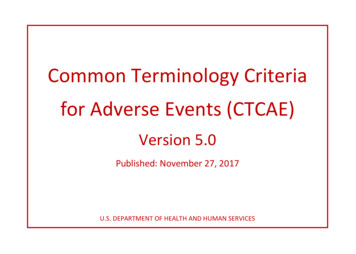
Transcription
Common Terminology Criteriafor Adverse Events (CTCAE)Version 5.0Published: November 27, 2017U.S. DEPARTMENT OF HEALTH AND HUMAN SERVICES
Common Terminology Criteria for Adverse Events (CTCAE) v5.0Publish Date: November 27, 2017IntroductionThe NCI Common Terminology Criteria forAdverse Events is a descriptive terminology whichcan be utilized for Adverse Event (AE) reporting. Agrading (severity) scale is provided for each AEterm.SOCSystem Organ Class (SOC), the highest level of theMedDRA 1 hierarchy, is identified by anatomical orphysiological system, etiology, or purpose (e.g.,SOC Investigations for laboratory test results).CTCAE terms are grouped by MedDRA PrimarySOCs. Within each SOC, AEs are listed andaccompanied by descriptions of severity (Grade).CTCAE TermsAn Adverse Event (AE) is any unfavorable andunintended sign (including an abnormallaboratory finding), symptom, or diseasetemporally associated with the use of a medicaltreatment or procedure that may or may not beconsidered related to the medical treatment orprocedure. An AE is a term that is a uniquerepresentation of a specific event used formedical documentation and scientific analyses.Each CTCAE v4.0 term is a MedDRA LLT (LowestLevel Term).1GradesGrade refers to the severity of the AE. The CTCAEdisplays Grades 1 through 5 with unique clinicaldescriptions of severity for each AE based on thisgeneral guideline:Grade 1 Mild; asymptomatic or mildsymptoms; clinical or diagnosticobservations only; interventionnot indicated.Grade 2 Moderate; minimal, local ornoninvasive interventionindicated; limiting ageappropriate instrumental ADL*.Grade 3 Severe or medically significant but notimmediately life-threatening;hospitalization or prolongationof hospitalization indicated;disabling; limiting self careADL**.Grade 4 Life-threatening consequences; urgentintervention indicated.Grade 5 Death related to AE.A Semi-colon indicates ‘or’ within the descriptionof the grade.Grade 5Grade 5 (Death) is not appropriate for some AEsand therefore is not an option.DefinitionsA brief Definition is provided to clarify themeaning of each AE term. A single dash (-)indicates a Definition is not available.Navigational NotesA Navigational Note is used to assist the reporterin choosing a correct AE. It may list other AEs thatshould be considered in addition to or in place ofthe AE in question. A single dash (-) indicates aNavigational Note has not been defined for the AEterm.Activities of Daily Living (ADL)*Instrumental ADL refer to preparing meals,shopping for groceries or clothes, using thetelephone, managing money, etc.**Self care ADL refer to bathing, dressing andundressing, feeding self, using the toilet, takingmedications, and not bedridden.A single dash (-) indicates a Grade is not available.Not all Grades are appropriate for all AEs.Therefore, some AEs are listed with fewer thanfive options for Grade selection.CTCAE v5.0 incorporates certain elements of the MedDRA terminology. For further details on MedDRA refer to the MedDRA MSSO Web site (https://www.meddra.org/).
Table of ContentsBlood and lymphatic system disorders . 4Cardiac disorders . 6Congenital, familial and genetic disorders . 12Ear and labyrinth disorders. 13Endocrine disorders . 15Eye disorders . 18Gastrointestinal disorders . 24General disorders and administration site conditions . 44Hepatobiliary disorders . 48Immune system disorders . 51Infections and infestations . 53Injury, poisoning and procedural complications . 70Investigations . 84Metabolism and nutrition disorders . 91Musculoskeletal and connective tissue disorders . 95Neoplasms benign, malignant and unspecified (incl cysts and polyps) . 103Nervous system disorders . 104Pregnancy, puerperium and perinatal conditions. 114Psychiatric disorders . 115Renal and urinary disorders . 119Reproductive system and breast disorders. 123Respiratory, thoracic and mediastinal disorders . 131Skin and subcutaneous tissue disorders . 142Social circumstances . 150Surgical and medical procedures . 151Vascular disorders . 152
Blood and lymphatic system disordersGrade 1Grade 2Grade 3Grade 4Grade 5AnemiaHemoglobin (Hgb) LLN - 10.0Hgb 10.0 - 8.0 g/dL; 6.2 - 4.9Hgb 8.0 g/dL; 4.9 mmol/L;Life-threateningDeathg/dL; LLN - 6.2 mmol/L; LLNmmol/L; 100 - 80g/L 80 g/L; transfusion indicatedconsequences; urgent- 100 g/Lintervention indicatedDefinition: A disorder characterized by a reduction in the amount of hemoglobin in 100 ml of blood. Signs and symptoms of anemia may include pallor of the skin and mucousmembranes, shortness of breath, palpitations of the heart, soft systolic murmurs, lethargy, and fatigability.Navigational Note: Bone marrow hypocellularMildly hypocellular or 25%Moderately hypocellular orSeverely hypocellular or 50 Aplastic persistent for longerDeathreduction from normal 25 - 50% reduction from 75% reduction cellularitythan 2 weekscellularity for agenormal cellularity for agefrom normal for ageDefinition: A disorder characterized by the inability of the bone marrow to produce hematopoietic elements.Navigational Note: Disseminated intravascularLaboratory findings with noLaboratory findings gconsequences; urgentintervention indicatedDefinition: A disorder characterized by systemic pathological activation of blood clotting mechanisms which results in clot formation throughout the body. There is an increase in therisk of hemorrhage as the body is depleted of platelets and coagulation factors.Navigational Note: Eosinophilia ULN and BaselineSteroids initiatedCTCAE TermDefinition: A disorder characterized by laboratory test results that indicate an increased number of eosinophils in the blood.Navigational Note: Febrile neutropeniaANC 1000/mm3 with a singleLife-threateningDeathtemperature of 38.3 degreesconsequences; urgentC (101 degrees F) or aintervention indicatedsustained temperature of 38 degrees C (100.4degrees F) for more than onehourDefinition: A disorder characterized by an ANC 1000/mm3 and a single temperature of 38.3 degrees C (101 degrees F) or a sustained temperature of 38 degrees C (100.4 degreesF) for more than one hour.Navigational Note: HemolysisLaboratory evidence ofEvidence of hemolysis andTransfusion or medicalLife-threateningDeathhemolysis only (e.g., direct 2 g decrease in hemoglobinintervention indicated (e.g.,consequences; urgentantiglobulin test; DAT;steroids)intervention indicatedCoombs'; schistocytes;decreased haptoglobin)Definition: A disorder characterized by laboratory test results that indicate widespread erythrocyte cell membrane destruction.Navigational Note: CTCAE v5.0 – November 27, 2017Back to TOCPage 4
CTCAE TermHemolytic uremic syndromeGrade 1Blood and lymphatic system disordersGrade 2Grade 3Laboratory findings withclinical consequences (e.g.,renal insufficiency, petechiae)Grade 4Life-threateningconsequences, (e.g., CNShemorrhage orthrombosis/embolism or renalfailure)Definition: A disorder characterized by a form of thrombotic microangiopathy with renal failure, hemolytic anemia, and severe thrombocytopenia.Navigational Note: Leukocytosis 100,000/mm3Clinical manifestations ofleucostasis; urgentintervention indicatedDefinition: A disorder characterized by laboratory test results that indicate an increased number of white blood cells in the blood.Navigational Note: Lymph node painMild painModerate pain; limitingSevere pain; limiting self careinstrumental ADLADLDefinition: A disorder characterized by a sensation of marked discomfort in a lymph node.Navigational Note: Methemoglobinemia ULNRequiring urgent interventionLife-threatening consequences-Definition: A disorder characterized by laboratory test results that indicate increased methemoglobin in the blood.Navigational Note: ThromboticLaboratory findings withthrombocytopenic purpuraclinical consequences (e.g.,renal insufficiency, petechiae)Grade , (e.g., CNShemorrhage orthrombosis/embolism or renalfailure)Definition: A disorder characterized by the presence of microangiopathic hemolytic anemia, thrombocytopenic purpura, fever, renal abnormalities and neurological abnormalities suchas seizures, hemiplegia, and visual disturbances. It is an acute or subacute condition.Navigational Note: Blood and lymphatic systemAsymptomatic or mildModerate; minimal, local orSevere or medically significantLife-threateningDeathdisorders - Other, specifysymptoms; clinical ornoninvasive interventionbut not immediately lifeconsequences; urgentdiagnostic observations only;indicated; limiting agethreatening; hospitalization orintervention indicatedintervention not indicatedappropriate instrumental ADLprolongation of existinghospitalization indicated;limiting self care ADLDefinition: Navigational Note: -CTCAE v5.0 – November 27, 2017Back to TOCPage 5
CTCAE TermAortic valve diseaseGrade 1Asymptomatic valvularthickening with or withoutmild valvular regurgitation orstenosis by imagingCardiac disordersGrade 2Asymptomatic; moderateregurgitation or stenosis byimagingDefinition: A disorder characterized by a defect in aortic valve function or structure.Navigational Note: AsystolePeriods of asystole; nonurgent medical managementindicatedGrade 3Symptomatic; severeregurgitation or stenosis byimaging; symptoms controlledwith medical interventionGrade 4Life-threateningconsequences; urgentintervention indicated (e.g.,valve replacement,valvuloplasty)Grade 5Death-Life-threateningconsequences; urgentintervention indicatedDeathDefinition: A disorder characterized by a dysrhythmia without cardiac electrical activity. Typically, this is accompanied by cessation of the pumping function of the heart.Navigational Note: Atrial fibrillationAsymptomatic, interventionNon-urgent medicalSymptomatic, urgentLife-threateningDeathnot indicatedintervention indicatedintervention indicated; deviceconsequences; embolus(e.g., pacemaker); ablation;requiring urgent interventionnew onsetDefinition: A disorder characterized by a dysrhythmia without discernible P waves and an irregular ventricular response due to multiple reentry circuits. The rhythm disturbanceoriginates above the ventricles.Navigational Note: Atrial flutterAsymptomatic, interventionNon-urgent medicalSymptomatic, urgentLife-threateningDeathnot indicatedintervention indicatedintervention indicated; deviceconsequences; embolus(e.g., pacemaker); ablationrequiring urgent interventionDefinition: A disorder characterized by a dysrhythmia with organized rhythmic atrial contractions with a rate of 200-300 beats per minute. The rhythm disturbance originates in theatria.Navigational Note: Atrioventricular blockNon-urgent interventionSymptomatic ely controlledconsequences; urgentmedically, or controlled withintervention indicateddevice (e.g., pacemaker); newonsetDefinition: A disorder characterized by a dysrhythmia with complete failure of atrial electrical impulse conduction through the AV node to the ventricles.Navigational Note: -CTCAE v5.0 – November 27, 2017Back to TOCPage 6
Cardiac disordersCTCAE TermGrade 1Grade 2Grade 3Grade 4Grade 5Atrioventricular block firstAsymptomatic, interventionNon-urgent interventiondegreenot indicatedindicatedDefinition: A disorder characterized by a dysrhythmia with a delay in the time required for the conduction of an electrical impulse through the atrioventricular (AV) node beyond 0.2seconds; prolongation of the PR interval greater than 200 milliseconds.Navigational Note: Cardiac arrestLife-threateningDeathconsequences; urgentintervention indicatedDefinition: A disorder characterized by cessation of the pumping function of the heart.Navigational Note: Chest pain - cardiacMild painModerate pain; pain onPain at rest; limiting self careexertion; limiting instrumentalADL; cardiac catheterization;ADL; hemodynamically stablenew onset cardiac chest pain;unstable anginaDefinition: A disorder characterized by substernal discomfort due to insufficient myocardial
Common Terminology Criteria . for Adverse Events (CTCAE) Version 5.0 . Published: November 27, 2017 . U.S. DEPARTMENT OF HEALTH AND HUMAN SERVICES
